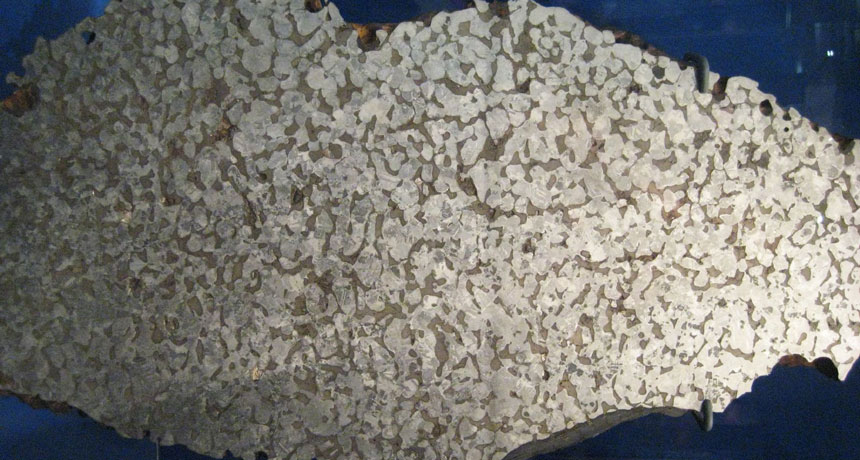
SURPRISE INSIDE Scientists found small amounts of superconducting materials within two meteorites, including Mundrabilla (above), discovered in 1966 in Western Australia.
Claire H./Wikimedia Commons (CC BY-SA 2.0)
- More than 2 years ago
LOS ANGELES — In the search for new superconductors, scientists are leaving no stone — and no meteorite — unturned. A team of physicists has now found the unusual materials, famous for their ability to conduct electricity without resistance, within two space rocks.
The discovery implies that small amounts of superconducting materials might be relatively common in meteorites, James Wampler of the University of California, San Diego, said March 6 at a meeting of the American Physical Society. While the superconducting materials found weren’t new to science, additional interplanetary interlopers might harbor new, more technologically appealing varieties of superconductors, the researchers suggest.
Superconductors could potentially beget new, energy-saving technologies, but they have one fatal flaw: They require very cold temperatures to function, making them impractical for most uses. So scientists are on the hunt for new types of superconductors that work at room temperature (SN: 12/26/15, p. 25). If found, such a substance could lead to dramatic improvements in power transmission, computing and high-speed magnetically levitated trains, among other things.
Space rocks are a good avenue to explore in the search for new, exotic materials, says Wampler. “Meteorites are formed under these really unique, really extreme conditions,” such as high temperatures and pressures.
What makes the meteorite superconductors special, the researchers say, is that they occurred naturally, instead of being fabricated in a lab, as most known superconductors are. In fact, says physicist Ivan Schuller, also of University of California, San Diego, these are the highest temperature naturally occurring superconductors known — although they still have to be superchilled to about 5 kelvins (–268.15° C) to work. They are also the first known to have formed extraterrestrially.
“At this point, it’s a novelty,” says chemist Robert Cava of Princeton University. Although Cava is skeptical that scrutinizing meteorites will lead to new, useful superconductors, he says, it’s “kinda cool” that superconductors show up in meteorites.
Wampler, Schuller and colleagues bombarded bits of powdered meteorite with microwaves and looked for changes in how those waves were absorbed as the temperature changed. The sensitive technique can pick out minute traces of superconducting material within a sample.
Analysis of powdered scrapings from more than a dozen meteorites showed that two meteorites contained superconducting material. However, the superconductors found within the meteorites were run-of-the-mill varieties, made from alloys of metals including indium, tin and lead, which are already known to superconduct.
“The idea is, try to look for something that is very unusual,” such as a room temperature superconductor, says Schuller, who led the research. So far, that hope hasn’t been realized — but that hasn’t deterred the search for something more exotic. For a previous study, Wampler, Schuller and colleagues scanned 65 tiny micrometeorites, but found no superconductors at all.
Since parts of space are colder than 5 kelvins, some meteorites may even contain materials that were once superconducting in their chilly natural habitat. That’s an interesting idea, Wampler says, although it’s too early to say whether that possibility might have any astronomical implications for how the objects behave out in space.







